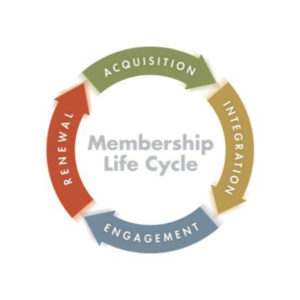 In prior months, we have explored the challenges and best practices of the Acquisition, Integration and Engagement stages of the Membership Life Cycle. In this month’s issue, we explore the best practices to implement for Stage 4: Renewal. If you missed the prior articles, you can access them on our website:
In prior months, we have explored the challenges and best practices of the Acquisition, Integration and Engagement stages of the Membership Life Cycle. In this month’s issue, we explore the best practices to implement for Stage 4: Renewal. If you missed the prior articles, you can access them on our website:
Stage 4: Renewal of Members
The renewal stage oftentimes reflects a quantitative measurement of how much members value the organization. Sure, some members may not renew due to factors outside of the organization’s control (e.g., business failure, merger, relocation, closure), although most renewals could be influenced proactively or reactively by the organization. The number one reason most members choose not to renew is they do not see the value in the membership and their expectations were not met. The second highest reason is simply that members forgot to renew or are preoccupied with other pressing priorities.
The most common challenges organizations face in this stage include:
- Lack of urgency by members to renew timely
- Members face resource constraints due to economic and business conditions
- Organizations are torn between terminating benefits after the renewal period or continuing to provide access to membership benefits to maintain relationships with members
- Lack of resources to manage the renewal process or to conduct outreach to non-responsive members
- Renewals based on a calendar year (January-December) catch members at a busy time of the year to remember or want to renew and may place smaller organizations in jeopardy financially if renewal revenue doesn’t arrive timely.
There are many strategies that are successful in improving the renewal stage. Make sure you start with implementing a strategic Retention Plan to minimize the number of pending renewals on the Aging Report. Our Member Retention Kit offers a step-by-step process to create a Retention Plan that can focus on specific retention challenge areas before determining other strategies to employ.
Best Practices for the Renewal Stage:
- Increase the frequency of renewal notices
-
- Send multiple renewal notices rather than multiple invoices—although they seem
interchangeable, notices and invoices are different. Jean Murray, author of U.S. Business Law/Taxes defines the difference as “An invoice is a bill sent by a provider of a product or service to the purchaser. The invoice establishes an obligation on the part of the purchaser to pay, creating an account receivable.” A membership renewal legally does not constitute an obligation on the part of the member to pay. Invoices should be sent only when a member or prospect has agreed to assume the obligation to pay. Plan on sending 7-10 renewal notices before the renewal date and after. (Our Member Retention Kit provides examples of renewal notices in Section V, Renewal and Reinstatement.)
-
- Make the renewal decision easier
- Offer Automatic Renewal Plans—offer payment options that are convenient and meet the needs of members including automatic credit card renewals or automatic monthly or quarterly credit card installment payments.
- Provide Discounts or Incentives for Renewal—offer discounts for multiple year memberships to reward members for acting proactively. Consider offering incentives such as discount coupons for upcoming events, free admission to an event, or eligibility for prize drawings for renewals paid by a deadline.
- Allow for Electronic Renewals—provide links to pay online in electronic renewal notices as this is more likely to generate a quicker response than if members must write a check and mail it with the invoice.
- Offer reinstatement options for lapsed members
- Use a “Win-Back” Program to Remarket to Lapsed Members—studies show that members are likely to rejoin if they have recently let their membership lapse for some reason. Offer to meet with members to discuss factors in their non-renewals and how to help them receive more value from their investments. Offer a discounted rate on the next year or other incentive such as a discount to a benefit they were interested in and didn’t use while they were a member previously. (Learn more about reinstatement strategies in the next issue of ACCE’s Chamber Executive magazine or in our Member Retention Kit in Section V, Renewal and Reinstatement.) Best practices for Win-Back Programs include:
- Identify the real reasons why members don’t renew
- Focus on quick win-back members (those you are most likely to get to rejoin)
- Make members feel they are being re-approached with sincerity
- Target dropped members with the highest Lifetime Values (those who have invested the most when calculating both dues and non-dues revenue since becoming a member)
- Use a “Win-Back” Program to Remarket to Lapsed Members—studies show that members are likely to rejoin if they have recently let their membership lapse for some reason. Offer to meet with members to discuss factors in their non-renewals and how to help them receive more value from their investments. Offer a discounted rate on the next year or other incentive such as a discount to a benefit they were interested in and didn’t use while they were a member previously. (Learn more about reinstatement strategies in the next issue of ACCE’s Chamber Executive magazine or in our Member Retention Kit in Section V, Renewal and Reinstatement.) Best practices for Win-Back Programs include:
Rather than assuming that the Renewal Stage and processes you implement are great as is, spend time really reviewing this stage and identifying areas for improvement. This may involve getting together with member services, accounting and other staff who play a role in the renewal stage and learning what each of them do specifically to support this stage. Have them work together on an improved process(es) to make the renewal stage more effective than before.
